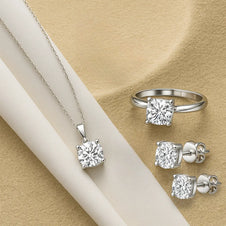Many people wonder where moissanite comes from. Unlike diamonds, moissanite is not mined from deep earth. Natural moissanite is extremely rare and found only in small traces. That’s why almost all moissanite rings today are made with lab-created stones.
Natural vs. Lab-Created Moissanite
Moissanite was first found in a meteor crater. Later, small traces were found in rocks. But these amounts are far too limited for jewelry. Lab-created moissanite gives us the same brilliance without mining. It is sustainable, affordable, and widely available for jewelry making.

Here’s a quick comparison:
|
Type
|
Source
|
Availability
|
Use in Jewelry
|
|
Natural Moissanite
|
Found in meteorites, rare rocks
|
Extremely rare
|
Not practical
|
|
Lab-Created Moissanite
|
Made in controlled labs
|
Widely available
|
Perfect choice
|
Why Jewelers Choose Lab Moissanite
Lab-grown moissanite has identical sparkle and fire to natural stones. Advanced technology ensures durability and clarity in every gem. Because it’s grown in labs, there’s no environmental damage from mining. This makes it a smart choice for modern buyers.
Benefits for Ring Buyers
Moissanite rings are brilliant, durable, and budget-friendly. They resist scratches and don’t lose shine over time. They also cost far less than mined diamonds of similar size. This makes them perfect for daily wear or special occasions.
Choosing Men’s Moissanite Rings
Men’s moissanite rings combine style with strength. They work well for engagements, weddings, or daily wear. At Celino Jewelry, our Mens Moissanite Rings are prepared with precision. Each ring balances bold design with lasting brilliance.
Final Thoughts
So, where do they mine moissanite rings? The answer is simple. They don’t. Natural moissanite is too rare to mine. The moissanite used in rings today comes from advanced labs. It shines bright, lasts long, and costs less. That’s why lab-created moissanite is the best choice for modern jewelry.








